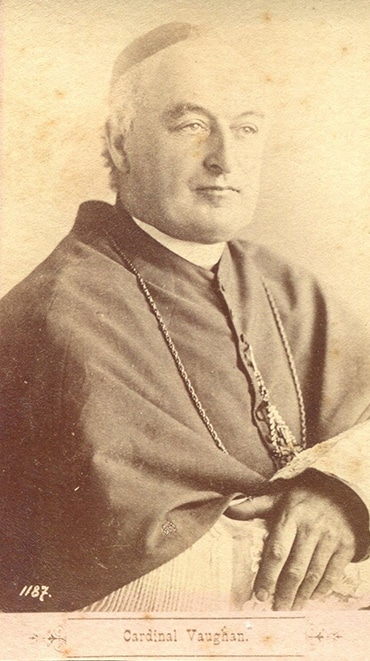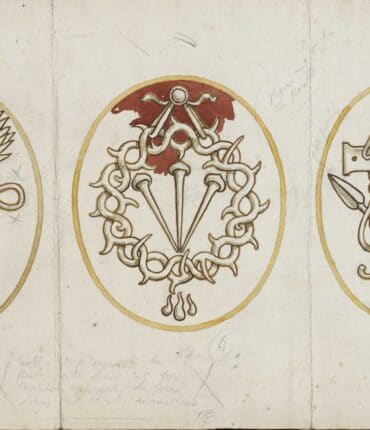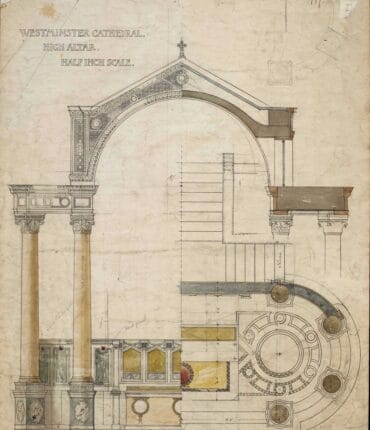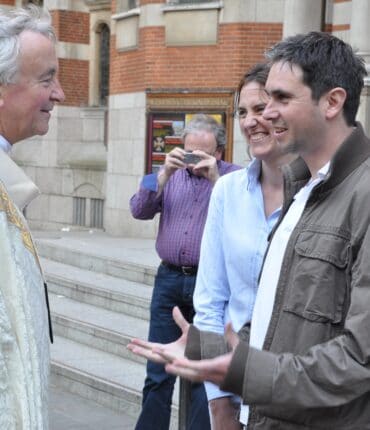
History of the Cathedral
Westminster Cathedral is relatively ‘modern’ in historical terms. Building only began in 1895 and the Cathedral was completed just eight years later in 1903 but its unique architecture reflects the influences of ancient Christian churches and its construction marks a pivotal moment in the history of the Church in England and Wales.
Rejection of a Gothic vision
On his appointment to Westminster, Cardinal Vaughan promised that a Cathedral would be built within ten years, but he was pragmatic. The diocese urgently needed a Cathedral – a statement of religious authority and the seat of the Archbishop’s ‘Cathedra’ – but it did not have unlimited funds. The new cathedral for Westminster would ultimately reflect many of the grand buildings of the industrial age; the mills and factories in brick which dominated the working landscape of Victorian Britain. Brick was significantly cheaper than stone, and readily available as a building material.
Vaughan had three key requirements for his new church: first, a broad uninterrupted nave with the high altar as the focus; second, a building whose structure could be completed first (the decoration could come later) and third, sensitive to the politics of the age, a desire not to compete with the Gothic grandeur of Westminster Abbey, a near neighbour. The Cardinal wanted a new vision for the new diocese, not a poor replica of the past.
An exciting new Cathedral for a new age
Cardinal Vaughan was familiar with the grand basilicas of Rome and he was convinced that an early Christian style church ‘of the Italian type’ was suitable for Westminster. In the late 19th century, Catholicism in England was enjoying a resurgence, boosted by an immigrant Irish population fleeing from famine and poverty, and the churches attracted large congregations. Vaughan rejected a narrow Gothic-style design in favour of a large interior space that referenced the ancient history of the Church.
We want the Empire to possess, in its very centre,
a living example of the beauty of the majesty of the Worship of God, rendered by solemn daily choral service
CARDINAL HERBERT VAUGHAN
Consecration
The timetable of ceremonies extended over three days from June 27 to June 29, the great feast of SS Peter and Paul. The Westminster Chronicle said it was, ‘an epoch in the history of the Catholic Church in England’.
The ceremonies began on 27 June with Exposition of the Relics in the Cathedral Hall and these were then sealed in silver caskets – one each for the 13 altars of the Cathedral. On the 28th the altars were consecrated, the silver caskets inserted into each altar in turn with Osmond Bentley, the architect’s elder son, assigned the task of sealing in the casket for the High Altar. A formal Mass of Dedication was sung by the Rt Rev John Baptist Cahill, Bishop of Portsmouth. Vespers and a Te Deum sung during Benediction marked the formal thanksgiving for the consecration of the Cathedral and the restoration of the Hierarchy. The ceremonies concluded on the Feast of SS Peter and Paul with a Mass sung by Archbishop Bourne and attended by the Lord Mayor of London; Vespers and Benediction at 4pm, followed by Compline, concluded the proceedings and a grand dinner was held at the Mansion House in the evening to mark the occasion and celebrate the achievement. Only 15 years previously the site ‘now covered by that stately monument of Catholic revival’ was a field.
Bentley’s name is not recorded in the Cathedral. In common with Christopher Wren, the building alone is his monument.



